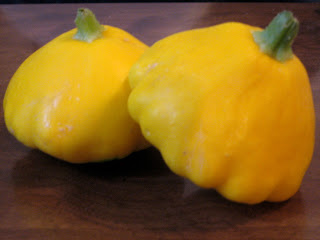Sunday's farmers market was overflowing with squash. Heaped high in wicker baskets, green and yellow beauties tumbled over each other in a gorgeous, edible-gem display one table after another. I couldn't resist. There were lovely yellow summer squash, an unreal shade of intense buttercup; curved gourd shapes, a paler yellow with cool green bottoms; and a basket of pattypan squash, green, yellow, and adorable.
Besides making mouth-watering pictures, squash make mouth-watering dishes, and dinner last night featured the "pattypan" squash, stuffed with other farmers market finds. The pattypan looks like a trippy overgrown acorn, and can be yellow or green in color, although I chose the yellow beauties. The squash has a summery taste, refreshing with a hint of sweetness when cooked.
Ingredients:
6 pattypan squash
 2 spring onions, or 1 medium sweet onion
2 spring onions, or 1 medium sweet onion3 garlic scapes (pictured at right), or 2 cloves of garlic
2/3 lb ground pork, or other ground meat
2-3 sprigs rosemary
2-3 sprigs thyme
olive oil
butter
salt and pepper to taste
1. Preheat oven to 400 degrees.
2. Wash and pat dry the squash. Cut off the top about one-third of the way down the squash so that you create a "body" and a "hat" out of the yellow beauts.
3. Scoop out the soft insides to create a squash shell cup, and reserve the flesh and seeds in a bowl. Place the squash shell in a baking dish, sprinkle with sea salt, and dot a smidgeon of butter on the bottom. Place the tops in the pan as well, dust with salt, and then into the oven they go. Set a timer for 45 minutes, and get ready to make the filling.
4. Chop up the spring onions and garlic scapes (the head through about 2/3 of the stem) into bite-sized pieces. Start a saute pan over medium low heat with a dab of butter and several drops of olive oil, adding the onion once the butter-oil combination is melted and hot. Give the onion about 5 minutes to get translucent, then add the scapes, cooking for about 5 more minutes.
5. The smells in the kitchen will be hunger-inducing at this point, so add the ground pork into your onion-scape mix, and cook for another 10 minutes, or until the pork is browned.
6. As the pork cooks, chop up about a cup of the squash innards, and throw them in the mix once the pork is brown. Add the rosemary, thyme, salt and pepper, and cook another few minutes. Let the mixture rest as the shells cook.
7. Timer beeping? Time to take the shells out of the oven, and fill them up with the pork mixture, trying to fill the shell up to the very top, or even a little bit beyond. Turn the oven to a broil, take the tops out of the baking dish and put them onto a plate, and then stick the stuffed squash back in the oven for 10 minutes.
This is a good recipe for entertaining, as the built-in serving dish of squash shell is edible, scrumptious, and eye-pleasingly presentable. The squash has a mellow sweetness that absorbs the woodsy herbs and pork for a thoroughly satisfying, juicy taste.









